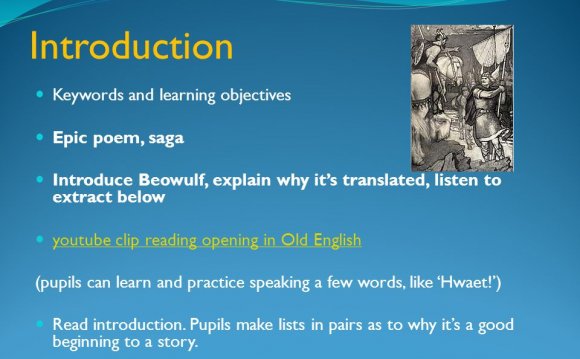
Consider the following sentence: "The girl saw the dog". How can you tell that this sentence does not mean that the dog is seeing the girl? The answer is obvious to an English speaker. "Girl" comes before the verb, and "dog" comes after it, and this arrangement tells us that the "girl" is performing the action of verb, and the "dog" is receiving the action. We say that the one who is performing the action of the verb is the "subject" of the verb. So "girl" is the "subject" of "saw". The dog, however, is the "object" of the verb, since it's the object of the action. And in English, we generally show these functions - subject and object - by position relative to the verb. The subject of the verb tends to come before the verb, the object tends to come after it.
But position isn't the only way we show which word is the subject and object of a verb. Now consider this sentence: "Him I like, them I despise". Obviously this sentence has an usual arrangement for rhetorical purposes, but how can you tell who is doing what to whom? Even though English grammar shows grammatical relationship between words in a sentence mainly by position, in many instances a change in the word itself provides you additional help. The word "him", although it comes first in the sentence, is not the subject because its form - "him" instead of "he" - is not the one used to indicate that it's the subject of the verb. We use the form "he" to show that. Furthermore, the word "I" is the form we use when the first person is subject of the verb. Hence, the words "he" and "I" change their forms as their grammatical function in the sentence changes. The change in form of a word to show grammatical functions is called "inflection".
The English personal pronouns change quite a lot to show you how they're being used in the sentence. Watch.
FORM FUNCTION I subject me object (something is being done to it) my possessor (it owns something First Person Pronoun we subject us object our possessor you subject you object your possessor Second Person Pronoun you subject you object your possessor he, she, it subject him, her, it object his, her, its possessor Third Person Pronoun they subject them object their possessor
This inflection (change of form to show grammatical function) in the pronouns is very useful for helping us to understand each other - although, as you can see, the second person pronoun "you, etc" doesn't inflect nearly so much as the first and third. The plural forms are even identical to the singular forms. We can still get by.
In English, inflection is rather limited, and we rely on position mainly to tell us what the words in the sentence are doing to each other. The only grammatical functions that involve a change in form for all nouns is the possessive case and the plural forms, where we attach an "-s" to the end of the word. (In written English we even include an apostrophe "'" mark to help us see the difference between a pluralized noun and a noun that's in the possessive case.) For example
SINGULAR PLURAL apple subject apples subject apple object apples object apple's possessor apples' possessor
Watch how we combine position with inflection in English to make sense to one another. As you can see, position is the principal guide.
"These apples' [plural, possessor] cores are hard, but apples [plural, subject] are usually soft. When you [singular, subject] buy apples [plural, object], you [singular, subject] should first pick up each apple [object, singular] and bounce it [singular, object] off the floor several times. Then check its [singular, possessor] skin. If it [singular, subject] is bruised, discretely put it [singular, object] back with the other apples [plural, object], making certain that no one [singular, subject] is watching you [singular, object]".Unlike English, languages which rely primarily on inflection of words to show grammatical relationship are called "inflected" languages. Modern English, though it has some inflection, is not an inflected language. Old English, is more inflected than Modern English but less inflected than Latin. It relies partly on changes in the words themselves to indicate their grammatical function in a sentence, and partly on other things like word order.
The different grammatical functions a word can have in a sentence is called "case". In Modern English there are three recognizable different cases, that is grammatical functions, a word can have: the subjective case, the possessive case, and the objective case. So we say there are three cases in Modern English. In Old English there are four difference cases. Here are the Old English cases. (Don't try to memorize them all at once here. Just read through the list; there will be plenty of time to firm up your familiarity of them.)
OLD ENGLISH APPROXIMATE ENGLISH EQUIVALENT Nominative (Subjective) Accusative (Objective Case) Genitive (Possessive Case) Dative (Object of words like "to" or "for")
Compare this with the six case that exist in Latin:
LATIN APPROXIMATE ENGLISH EQUIVALENT Nominative (Subjective) Accusative (Objective Case) Genitive (Possessive Case) Dative (Object of words like "to" or "for") Ablative (Adverbial Usages: "by", "with") Vocative (Direct Address)
We'll look at the way these cases are used in Old English in the next part of these notes, although some of them won't be difficult at all: the nominative, genitive, and accusative cases are almost the same as their English counterparts. The dative will need some explanation. Before then, however, let's look at how a Old English noun inflects to show all these different cases.
Let's look at some Modern English pronouns which inflect to show the three different cases. Do you remember "they, them, their, ?" The pronoun is inflecting through its different cases, but we can definitely spot a pattern of similarity among the three forms. There is a definite root of the word. The root (that is, the part of the word that contains the meaning of the word) is "the-" to which then the endings "-y", "-m" and "-ir". So we could say that the word is inflecting by adding certain case endings to a stem. The stem contains the core of the meaning of the word, and the endings merely inflect or alter its grammar.
Personal Pronouns
So how does this work in Old English. Let's look again at the personal pronouns:
MODERN ENGLISH CASE OLD ENGLISH 1st Person Singular I Nominative ic me Accusative me, mec my (mine) Genitive min me Dative me Plural we Nominative we us Accusative us our Genitive ure us Dative us 2nd Person Singular you (thou) Nominative þu you (thee) Accusative þe, þec your (thine) Genitive þin you (thee) Dative þe Plural you Nominative ge you Accusative eow your Genitive eower you Dative eow 3rd Person Singular he Nominative he him Accusative hine his Genitive his him Dative him she Nominative heo, hio her Accusative hie, hi her Genitive hire her Dative hire it Nominative hit it Accusative hit its Genitive his it Dative him Plural they Nominative hie, hi them Accusative hie, hi their Genitive hira, hiera, heora, hiora them Dative him, heom
Old English also has another type of personal pronoun which has not survived into Modern English. These pronouns cover the special case of two people, as in "we two went to the cinema" or "you two went to the cinema". These two phrases sound correct in Modern English. However, consider the phrase "they two went to the cinema". This does not sound correct. Similarly in Old English the dual pronouns can only be used for the first and second persons. Their forms are shown below:
MODERN ENGLISH CASE OLD ENGLISH 1st Person Dual we two Nominative wit Accusative unc Genitive uncer Dative unc 2nd Person Dual you two Nominative git Accusative inc Genitive incer Dative inc
MORE TRANSLATION VIDEO












